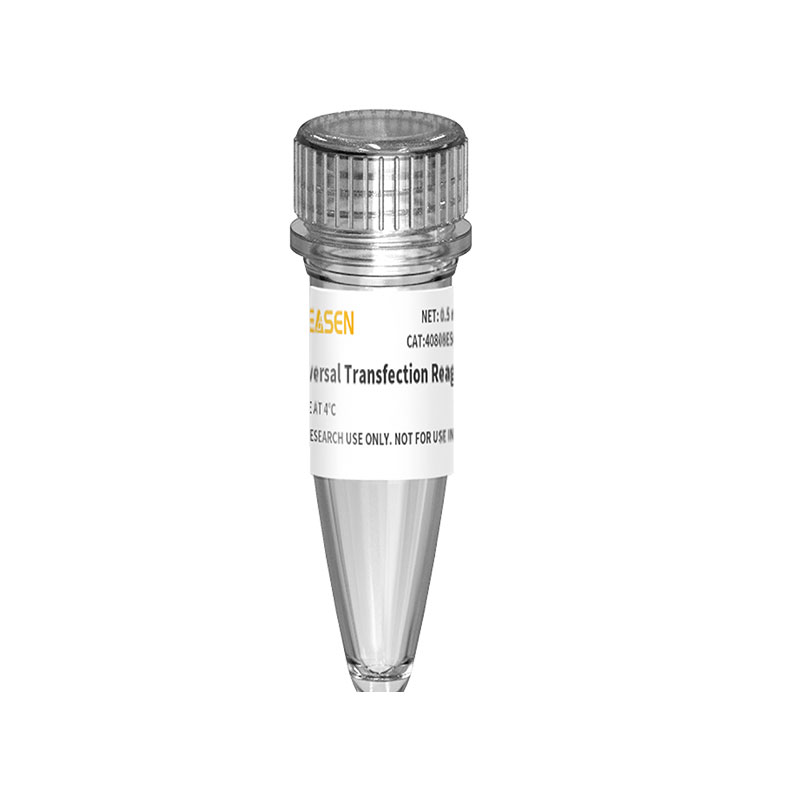Hieff Trans™ Universal Transfection Reagent
Product Description
Hieff Trans™ universal transfection reagent is a multi-purpose, convenient and efficient liposome transfection reagent developed based on the latest nanotechnology. It is suitable for the transfection of DNA, RNA and oligonucleotides, including primary cells, Difficult-to-transfect cells, including neurons, have high transfection efficiency. Its unique formula allows it to be added directly to the medium, and the presence of serum does not affect transfection efficiency, which reduces the damage to cells caused by serum removal. It is not necessary to remove the nucleic acid-transfection reagent complex or replace with fresh medium after transfection, and the fresh medium can also be replaced after 4-6 hours according to the nutrient status of the cells.
Product Components
|
Component Number |
Components |
Cat#/Size |
||
|
40808ES02 |
40808ES03 |
40808ES03 |
||
|
40808-A |
Universal-A |
0.5 mL |
1 mL |
5×1 mL |
|
40808-B |
Universal-B |
0.5 mL |
1 mL |
5×1 mL |
Shipping and Storage
The product is shipped with ice packs and can be stored at 2-8℃ for one year. Do not freeze!
Cautions
1) During the transfection operation, it is better that the cell confluence reaches 70%-90%, and the specific plating density is determined according to the situation of the cells.
2) Preparation of transfection complexes requires dilution of DNA and transfection reagents in serum-free medium.
3) Antibiotics cannot be added to the medium during transfection.
4) The use of high-purity DNA or RNA helps to obtain higher transfection efficiency, and endotoxin in plasmids is the enemy of transfection.
5) Store at 2-8ºC, be careful not to open the lid repeatedly for a long time.
6) The nucleic acid concentration and reagent volume should be optimized for the first use to obtain the maximum transfection efficiency.
7) This product is for scientific research purposes only!
Instructions
Transfection of DNA
[Note] The amount of transfection reagent used is affected by the cell type and other experimental conditions. It is recommended to set a gradient to optimize the optimal amount of use for the first time.
1) The cells are plated, and the cell confluence should be 70%-90% by the time of transfection.
2) Dilute the Universal-B solution with Opti-MEM medium according to the table below and mix gently.
3) Dilute DNA with Opti-MEM medium to obtain DNA premix, then add Universal-A solution and mix gently to obtain diluted DNA.
4) Add the diluted DNA to the diluted Universal-B solution (1:1 ratio).
5) Incubate at room temperature for 5 minutes.
6) Add the DNA-liposome complex to the cells dropwise and mix gently.
7) Incubate at 37°C, 5% CO2 incubator for 48-96 h until gene expression analysis.
Transfection of siRNA
The procedure for transfection of siRNA is the same as that for DNA transfection, except that Universal-A solution (step 3) does not need to be added when diluting siRNA.
Table 1 The amount of transfection in different cell culture vessels (for reference only)
|
Cell culture vessels |
96-well |
24-well |
6-well |
|
|
Adherent cells |
1-4×104 |
0.5-2×105 |
0.25-1×106 |
|
|
Dilute the Universal-B solution with Opti-MEM medium according to the table below and mix gently. |
Opti-MEM medium |
5 μL |
25 μL |
125 μL |
|
Universal-B |
0.2 μL |
1 μL |
5 μL |
|
|
Dilute DNA with Opti-MEM medium to obtain DNA premix, then add Universal-A solution and mix gently to obtain diluted DNA. |
Opti-MEM medium |
5 μL |
25 μL |
125 μL |
|
DNA (0.5–5 μg/μL) |
0.1 μg |
0.5 μg |
2.5 μg |
|
|
Universal-A(2 μL/μg DNA) |
0.2 μL |
1 μL |
5 μL |
|
|
Add the diluted DNA to the diluted Universal-B solution (1:1 ratio). |
Diluted DNA solution |
5 μL |
25 μL |
125 μL |
|
Universal-B |
5 μL |
25 μL |
125 μL |
|
|
Incubate at room temperature for 5 minutes. |
||||
|
DNA-Liposome Complex |
Components(each well) |
96-well |
24-well |
6-well |
|
Opti-MEM |
10 μL |
50 μL |
250 μL |
|
|
DNA(0.5–5 μg/μL) |
0.1 μg |
0.5 μg |
2.5 μg |
|
|
Universal-B |
0.2 μL |
1 μL |
5 μL |
|
|
Universal-A |
0.2 μL |
1 μL |
5 μL |
|
|
Add the DNA-liposome complex to the cells dropwise and mix gently. |
DNA-Liposome Complex |
10 μL |
50 μL |
250 μL |
[Note] The amount used in the table is for reference only. The specific amount of DNA and Universal-B solution used should be optimized according to the cell type and other experimental conditions. It is recommended to keep the ratio between 1:0.5-1:5.
(1) Q: Can serum be present when preparing nucleic acid transfection reagent complex?
A: The presence of serum will affect the formation of liposomes. It is recommended to use serum-free medium (generally MEM medium) when preparing nucleic acid transfection reagent complexes.
(2) Q: Can the transfection reagent be frozen?
A: This reagent must be stored at 2-8°C, and should be avoid repeated and prolonged opening of the cap, as long-term opening of the cap will cause liposome oxidation and affect the transfection efficiency.
(3) Q: What should I pay attention to when using Hieff Trans™ Universal Transfection Reagent?
A: 1) During the transfection operation, it is better that the cell confluence reaches 70%-90%, and the specific plating density is determined according to the situation of the cells.
2) Preparation of transfection complexes requires dilution of DNA and transfection reagents in serum-free medium.
3) Antibiotics cannot be added to the medium during transfection.
4) The use of high-purity DNA or RNA helps to obtain higher transfection efficiency, and endotoxin in plasmids is the enemy of transfection.
5) Store at 2-8ºC, be careful not to open the lid repeatedly for a long time.
6) The nucleic acid concentration and reagent volume should be optimized for the first use to obtain the highest transfection efficiency.
(4) Q: Does it need to be terminated after transfection?
A: No need. It is not necessary to remove the nucleic acid-transfection reagent complex or replace with fresh medium after transfection, and the fresh medium can also be replaced after 4-6 hours according to the nutrient status of the cells.
(5) Q: Can the transfection reagent be used for transfection of viral vector packaging?
A: Yes. The efficiency of viral vector packaging is not necessarily related to the efficiency of transfection, but also to the selection of packaging plasmids and the ratio between plasmids.
Catalog No.:*
Name*
phone Number:*
Lot:*
Email*
Country:*
Company/Institute:*

